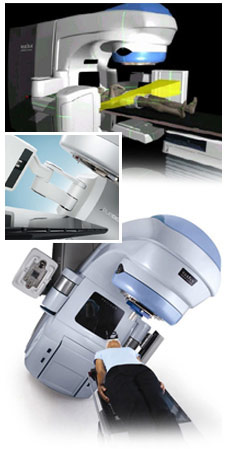Several different radiation therapy techniques have been developed to accomplish this. Depending on the location, size and type of your tumor or tumors, you may receive one or a combination of these techniques. The IGRT cancer treatment team will work with you to determine which treatment and how much radiation is best for you.
How It Works
 During external beam radiation therapy, a beam of radiation is directed through the skin to a tumor and the immediate surrounding area in order to destroy the main tumor and any nearby cancer cells. To minimize side effects, the treatments are typically given every day for a number of weeks.
During external beam radiation therapy, a beam of radiation is directed through the skin to a tumor and the immediate surrounding area in order to destroy the main tumor and any nearby cancer cells. To minimize side effects, the treatments are typically given every day for a number of weeks.
The radiation beam comes from a machine located outside of your body that does not touch your skin or the tumor. Receiving external beam radiation is similar to having an X-ray taken. It is a painless, bloodless procedure. The most common type of machine used to deliver external beam radiation therapy is called a linear accelerator, sometimes called a “linac.” It produces a beam of high-energy X-rays or electrons. Using sophisticated treatment planning software, your radiation oncology treatment team plans the size and shape of the beam, as well as how it is directed at your body, to effectively treat your tumor while sparing the normal tissue surrounding the cancer cells.
IGRT uses three types of external beam therapy, depending on what types of cancer are being addressed.
Image Guided Radiation Therapy (IGRT)
Normal structures and tumors can move between treatments due to differences in organ filling or movements while breathing. IGRT is radiation therapy, or often IMRT for deep seated tumors, guided by imaging equipment such as CT, ultrasound or stereoscopic X-rays that are taken in the treatment room just before the radiation is delivered. All patients first undergo a CT scan as part of the planning process. The digital information from the CT scan is then transmitted to the treatment console to allow the therapists to compare the earlier image with the images taken just prior to treatment. This allows for better targeting of the cancer while avoiding nearby healthy tissue. In some cases, a tiny piece of material called a fiducial marker may be implanted near or in the tumor to help localize the tumor during IGRT.
Intensity Modulated Radiation Therapy (IMRT)
Intensity modulated radiation therapy (IMRT) is a specialized form of 3D-CRT that allows radiation to be more exactly shaped to fit your tumor. With IMRT, the radiation beam can be broken up into many “beamlets,” and the intensity of each beamlet can be adjusted individually. Using IMRT, it may be possible to further limit the exact amount of radiation that is received by normal tissues that are near the tumor. In some situations, this may also allow a higher dose of radiation to be delivered to the tumor, increasing the chance of a cure.
Three-Dimensional Conformal Radiation Therapy (3D-CRT)
Tumors usually have an irregular shape. Three-dimensional conformal radiation therapy (3D-CRT) uses sophisticated computers and computer assisted tomography scans (CT or CAT scans) and/or magnetic resonance imaging scans (MR or MRI scans) to create detailed, three-dimensional representations of the tumor and surrounding organs. Dr. Puranik can then shape the radiation beams exactly to the size and shape of your tumor. The tools used to shape the radiation beams are multi-leaf collimators or blocks. Because the radiation beams are very precisely directed, nearby normal tissue receives less radiation exposure.

